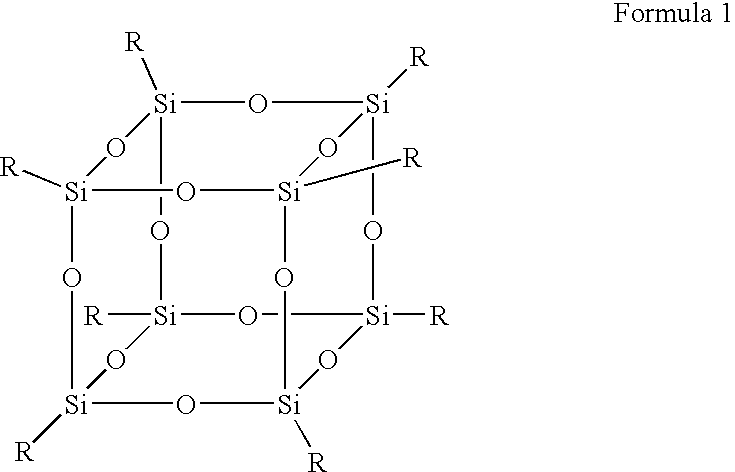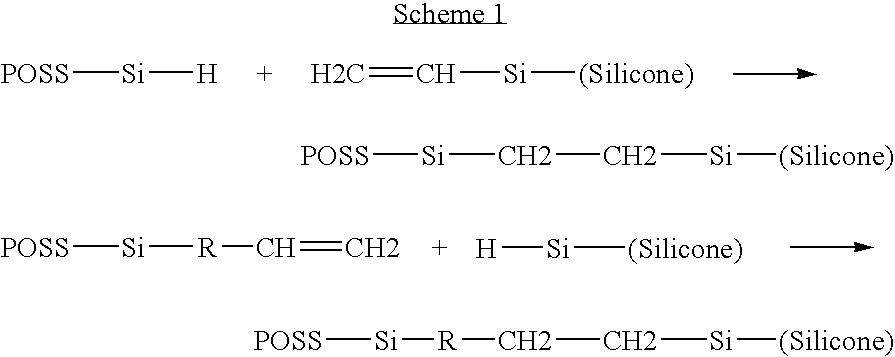Polysilsesquioxane containing polymeric compositions
- Summary
- Abstract
- Description
- Claims
- Application Information
AI Technical Summary
Benefits of technology
Problems solved by technology
Method used
Image
Examples
example 1
Preparation of Polymeric Composition with Norbornenylethyl Isobutyl-POSS:
[0047]A glass vial is charged with 2.3 grams (2.45 milimole of vinyl) of norbornenylethyl isobutyl-POSS (Hybrid Plastics, Fountain Valley, Calif.) and 15 mL of tetrahydrofuran. The mixture was stirred until all POSS powder is dissolved. Then 0.7 grams (4.45 millimole of Si—H) of methylhydrosiloxane-dimethylsiloxane (50 / 50) of Mn around 1050 (Gelest Inc., Tullytown, Pa.) and 7.0 grams (0.254 millimole of vinyl) of vinyl-terminated diphenylsiloxane-dimthylsiloxane copolymer (15–17%) of Mn 55,000 (Gelest Inc., Tullytown, Pa.) are added and well mixed. The solvent is then removed under reduced pressure. Then 1.0 mg of Platinum(0)-cyclovinylmethysiloxane complex (Gelest Inc., Tullytown, Pa.) is added into the silicone mixture and mixed well prior to degassing. The mixture is then cast between two silane-treated glass plates and cured at 100° C. for two hours. The cured film is optically clear.
example 2
Preparation of Polymeric Composition with Trisnorbornenylethyl Isobutyl-POSS:
[0048]The procedure is the same as that of Example 1 except that 1.8 grams (4.07 milimole of vinyl) trisnorbornenylethyl-POSS (Hybrid Plastics, Fountain Valley, Calif.) is used to replace norbornenylethyl isobutyl-POSS and 1.2 gram (7.64 millimole of Si—H) methylhydrosiloxane-dimethylsiloxane (50 / 50) copolymer is used. The cured film is optically clear.
example 3
Preparation of Polymeric Composition with Tris(vinyldimethyl)Isobutyl-POSS:
[0049]The procedure is the same as that of Example 1 except that 1.8 grams (5.17 milimole of vinyl) of tris(vinyldimethyl)isobutyl-POSS (Hybrid Plastics, Fountain Valley, Calif.) is used rather than norbornenylethyl isobutyl-POSS and 1.2 gram (7.64 millimole of Si—H) methylhydrosiloxane-dimethylsiloxane (50 / 50) copolymer is used. The cured film is optically clear.
PUM
| Property | Measurement | Unit |
|---|---|---|
| Flexibility | aaaaa | aaaaa |
| Acidity | aaaaa | aaaaa |
Abstract
Description
Claims
Application Information
 Login to View More
Login to View More - R&D
- Intellectual Property
- Life Sciences
- Materials
- Tech Scout
- Unparalleled Data Quality
- Higher Quality Content
- 60% Fewer Hallucinations
Browse by: Latest US Patents, China's latest patents, Technical Efficacy Thesaurus, Application Domain, Technology Topic, Popular Technical Reports.
© 2025 PatSnap. All rights reserved.Legal|Privacy policy|Modern Slavery Act Transparency Statement|Sitemap|About US| Contact US: help@patsnap.com



